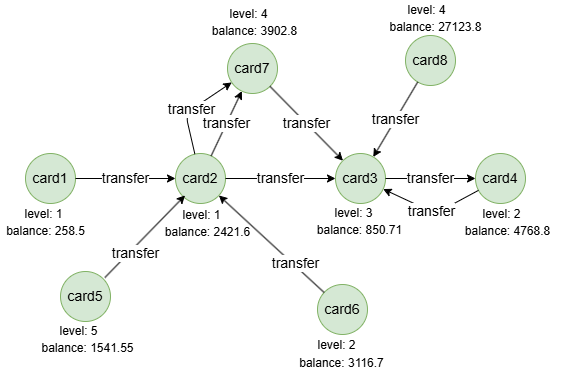Overview
The K-Hop All algorithm identifies the neighborhood of each node within a graph. This algorithm finds extensive application in various scenarios, including relationship discovery, impact prediction, and friend suggestion.
The K-Hop All algorithm can be considered as the batch execution of the UQL K-Hop Query.
Considerations
Although the K-Hop All algorithm is optimized for high concurrency performance, it is important to note that this algorithm may require significant computational resources when dealing with large graphs (those with tens of millions of nodes or edges), or graphs containing many super nodes. To optimize performance, it is advisable to avoid performing K-Hop All calculation that is excessively deep, considering the specific characteristics and size of the graph being analyzed.
In graph G = (V, E), if |V|/|E|=100, querying the 5-hop neighbors of a node requires a theoretical computational complexity of 105 (equivalent to 10 billion computations), which would take approximately 100ms. Extrapolating from this, completing such a query in a graph with 10 million nodes would require 1 million seconds (equivalent to around 12 days). It's important to consider the computational demands and time requirements when working with graphs of this scale.
Example Graph

To create this graph:
// Runs each row separately in order in an empty graphset
create().node_schema("card").edge_schema("transfer")
create().node_property(@card, "level", int32).node_property(@card, "balance", double)
insert().into(@card).nodes([{_id:"card1", level:1, balance:258.5}, {_id:"card2", level:1, balance:2421.6}, {_id:"card3", level:3, balance:850.71}, {_id:"card4", level:2, balance:4768.8}, {_id:"card5", level:5, balance:1541.55}, {_id:"card6", level:2, balance:3116.7}, {_id:"card7", level:4, balance:3902.8}, {_id:"card8", level:4, balance:27123.8}])
insert().into(@transfer).edges([{_from:"card1", _to:"card2"}, {_from:"card2", _to:"card3"}, {_from:"card2", _to:"card7"}, {_from:"card2", _to:"card7"}, {_from:"card3", _to:"card4"}, {_from:"card4", _to:"card3"}, {_from:"card5", _to:"card2"}, {_from:"card6", _to:"card2"}, {_from:"card7", _to:"card3"}, {_from:"card8", _to:"card3"}])
Creating HDC Graph
To load the entire graph to the HDC server hdc-server-1 as hdc_khop_all:
CALL hdc.graph.create("hdc-server-1", "hdc_khop_all", {
nodes: {"*": ["*"]},
edges: {"*": ["*"]},
direction: "undirected",
load_id: true,
update: "static",
query: "query",
default: false
})
hdc.graph.create("hdc_khop_all", {
nodes: {"*": ["*"]},
edges: {"*": ["*"]},
direction: "undirected",
load_id: true,
update: "static",
query: "query",
default: false
}).to("hdc-server-1")
Parameters
Algorithm name: khop_all
Name |
Type |
Spec |
Default |
Optional |
Description |
|---|---|---|---|---|---|
ids |
[]_id |
/ | / | Yes | Specifies nodes for computation by their _id; computes for all nodes if it is unset. |
uuids |
[]_uuid |
/ | / | Yes | Specifies nodes for computation by their _uuid; computes for all nodes if it is unset. |
k_start |
Integer | ≥1 | 1 |
Yes | Specifies the starting depth for the K-Hop query, defining the querying depth range as [k_start, k_end]. |
k_end |
Integer | ≥1 | 1 |
Yes | Specifies the ending depth for the K-Hop query, defining the querying depth range as [k_start, k_end]. |
direction |
String | in, out |
/ | Yes | Specifies the direction of all edges in the shortest paths. |
node_property |
[]"<@schema.?><property>" |
/ | / | Yes | Numeric node properties to perform aggregations. This option must be used with aggregate_opt. |
aggregate_opt |
[]String | max, min, mean, sum, var, dev |
/ | Yes | Specifies the types of aggregations to perform on the values of the given node properties. This option must be used with node_property, where each aggregation type corresponds to one property.The aggregation types include:
|
src_include |
Integer | 0, 1 |
0 |
Yes | Whether to include the source node in the results; sets to 1 to include, or 0 to exclude. |
return_id_uuid |
String | uuid, id, both |
uuid |
Yes | Includes _uuid, _id, or both to represent nodes in the results. |
limit |
Integer | ≥-1 | -1 |
Yes | Limits the number of results returned; -1 includes all results. |
File Writeback
This algorithm can generate two files:
Spec |
Content |
|---|---|
filename_ids |
|
filename |
|
CALL algo.khop_all.write("hdc_khop_all", {
params: {
return_id_uuid: "id",
ids: ["card1", "card7"],
k_start: 2,
k_end: 3,
direction: "out",
node_property: ["@card.level", "@card.balance"],
aggregate_opt: ["sum", "mean"]
},
return_params: {
file: {
filename_ids: "neighbors",
filename: "aggregations"
}
}
})
algo(khop_all).params({
projection: "hdc_khop_all",
return_id_uuid: "id",
ids: ["card1", "card7"],
k_start: 2,
k_end: 3,
direction: "out",
node_property: ["@card.level", "@card.balance"],
aggregate_opt: ["sum", "mean"]
}).write({
file: {
filename_ids: "neighbors",
filename: "aggregations"
}
})
Results:
_id,_id
card1,card3
card1,card7
card1,card4
card7,card4
_id,sum,mean,count
card1,9,3174.1,3
card7,2,4768.8,1
DB Writeback
Writes the aggregation results (if has) and the count values to the specified node properties. The property type is double.
CALL algo.khop_all.write("hdc_khop_all", {
params: {
k_start: 2,
k_end: 2,
node_property: ["@card.level", "@card.level", "@card.balance"],
aggregate_opt: ["sum", "mean", "mean"]
},
return_params: {
db: {
property: "khop2"
}
}
})
algo(khop_all).params({
projection: "hdc_khop_all",
k_start: 2,
k_end: 2,
node_property: ["@card.level", "@card.level", "@card.balance"],
aggregate_opt: ["sum", "mean", "mean"]
}).write({
db: {
property: "khop2"
}
})
The aggregation results are written to new properties sum, mean and mean1; the count values are written to the new property khop2.
Full Return
CALL algo.khop_all("hdc_khop_all", {
params: {
return_id_uuid: "id",
ids: ["card1", "card7"],
k_start: 2,
k_end: 3,
node_property: ["@card.level", "@card.balance"],
aggregate_opt: ["max", "mean"]
},
return_params: {}
}) YIELD r
RETURN r
exec{
algo(khop_all).params({
return_id_uuid: "id",
ids: ["card1", "card7"],
k_start: 2,
k_end: 3,
node_property: ["@card.level", "@card.balance"],
aggregate_opt: ["max", "mean"]
}) as r
return r
} on hdc_khop_all
Result:
| _id | max | mean | count |
|---|---|---|---|
| card1 | 5 | 6884.06 | 6 |
| card7 | 5 | 7361.87 | 5 |
Stream Return
CALL algo.khop_all("hdc_khop_all", {
params: {
return_id_uuid: "id",
ids: "card2",
k_start: 2,
k_end: 2,
node_property: ["@card.level", "@card.balance"],
aggregate_opt: ["max", "max"]
},
return_params: {
stream: {}
}
}) YIELD results
RETURN results
exec{
algo(khop_all).params({
return_id_uuid: "id",
ids: "card2",
k_start: 2,
k_end: 2,
node_property: ["@card.level", "@card.balance"],
aggregate_opt: ["max", "max"]
}).stream() as results
return results
} on hdc_khop_all
Result:
| _id | max | max1 | count |
|---|---|---|---|
| card2 | 4 | 27123.8 | 2 |

